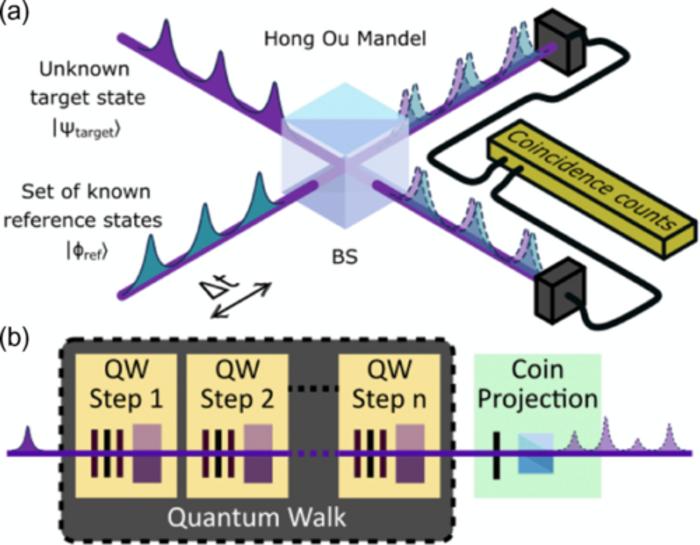Australian scientists have developed an innovative technique that makes quantum information encoded in light more practical and reliable, potentially transforming secure communications and quantum computing. The breakthrough, published May 6 in Physical Review Letters, elegantly solves a persistent challenge in quantum communication by simplifying how information is processed in photons—the tiny particles that make up light—without sacrificing performance or security.
Solving the Quantum Measurement Challenge
Quantum information can be stored in the precise timing of individual photons, known as “time-bin encoding.” However, traditional approaches to measuring these precisely timed signals have required extremely complex and unstable equipment, creating significant hurdles for real-world applications.
The research team from Griffith University’s Queensland Quantum and Advanced Technologies Research Institute (QUATRI) bypassed these challenges using a quantum effect called Hong-Ou-Mandel (HOM) interference.
“Think of it as the universe’s version of an awkward handshake that actually achieves something useful,” explains Dr. Simon White, one of the study’s lead researchers.
This quantum effect occurs when two identical photons meet at a beam splitter, behaving in ways that defy classical physics but can be harnessed for practical applications.
From Qubits to Qudits: Expanding Information Capacity
The technique combines HOM interference with a “quantum walk”—a process describing how single photons move across different paths in time. This combination unlocks access to high-dimensional quantum signals called qudits.
Unlike classical bits (0 or 1) or standard quantum bits (qubits), qudits can exist in multiple states simultaneously, dramatically increasing information capacity and security potential.
“Photons are ideal carriers of quantum information, and encoding information in a photon’s arrival time is a great way to send a quantum message,” Dr. White said. “We show how to simplify the measurement of these messages so detectors don’t need to resolve the individual time of arrival; instead we only need to observe the interference.”
Remarkable Precision in the Lab
The experimental results demonstrate the technique’s exceptional reliability:
- Over 99% fidelity in quantum state measurements
- Scalable beyond two dimensions
- Successfully generated quantum entanglement between different properties of single photons
- Works with short temporal separations between time bins
Dr. Emanuele Polino, the study’s other lead researcher, highlighted the significance of demonstrating quantum entanglement in their system.
“Entanglement is a key property of quantum mechanics,” Dr. Polino said. “Demonstrating the presence of entanglement is important as it gives insight into how these quantum properties can be used in the future.”
Real-World Applications on the Horizon
What makes this development particularly valuable is its potential for practical implementation. The approach reduces the technical complexity and increases the stability of quantum communication systems—two critical factors for moving quantum technologies out of the lab and into everyday applications.
The simplified measurement technique could accelerate development in several areas:
“Sending secure quantum signals is a difficult task, but encoding using time-based qudits makes that task easier and more robust,” said Dr. White. “By improving the stability, versatility, and simplicity of time-bin quantum encoding, this breakthrough brings us closer to scalable quantum technologies.”
The technology could serve as a foundation for unhackable communications, more powerful quantum computers, and advanced quantum sensing devices.
The Growing Quantum Landscape
This advancement comes amid growing global interest in quantum technologies, with governments and companies increasingly investing in quantum research and development.
While many quantum innovations remain primarily theoretical or restricted to laboratory environments, this approach from Griffith University researchers represents the kind of practical advance that could help bridge the gap between quantum theory and real-world implementation.
“This work helps us better see the foundational properties of quantum particles and opens new possibilities for secure communication, advanced quantum simulation, and real-world quantum applications. And honestly, we think that is pretty important,” Dr. White concludes.
As quantum technologies continue to mature, breakthroughs that simplify implementation while maintaining high performance—like this one—may prove crucial in determining which quantum approaches ultimately succeed in the marketplace.
If our reporting has informed or inspired you, please consider making a donation. Every contribution, no matter the size, empowers us to continue delivering accurate, engaging, and trustworthy science and medical news. Independent journalism requires time, effort, and resources—your support ensures we can keep uncovering the stories that matter most to you.
Join us in making knowledge accessible and impactful. Thank you for standing with us!

